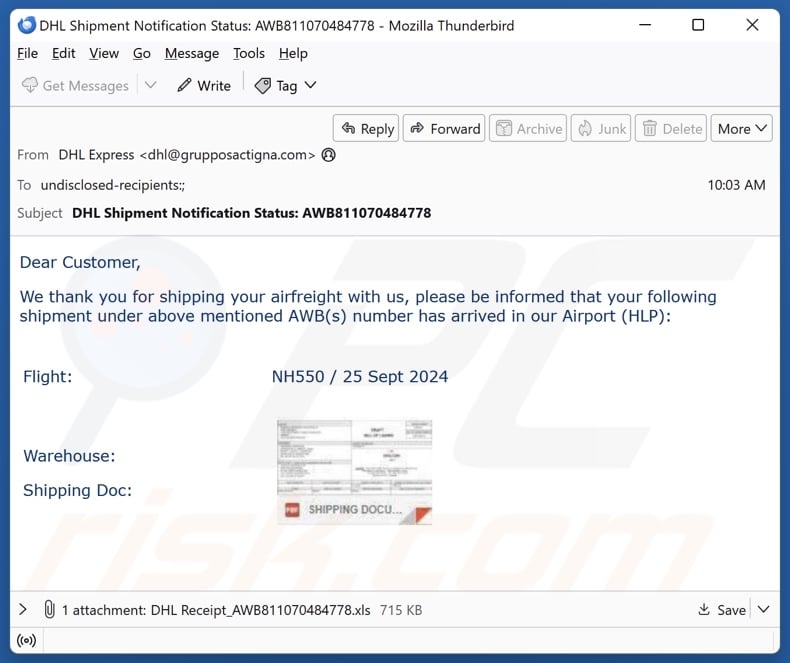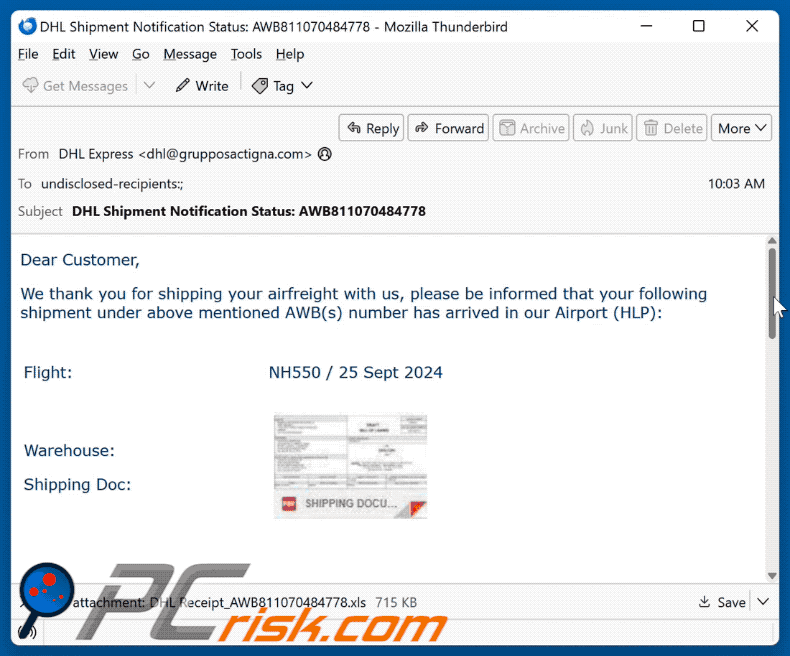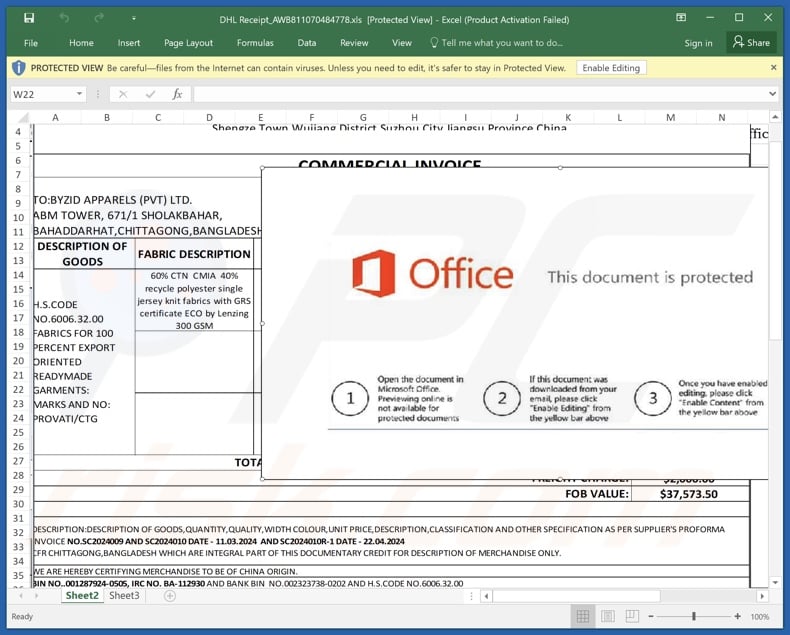Avoid infecting your device with malware via fake "DHL Airfreight" emails
Phishing/ScamAlso Known As: "DHL Airfreight" malspam
Get free scan and check if your device is infected.
Remove it nowTo use full-featured product, you have to purchase a license for Combo Cleaner. Seven days free trial available. Combo Cleaner is owned and operated by RCS LT, the parent company of PCRisk.com.
What kind of email is "DHL Airfreight"?
After investigating this "DHL Airfreight" email, we determined that it is malspam. This fake message is presented as a notification from the DHL logistic company concerning the arrival of a shipment.
The purpose of this spam mail is to infect recipients' devices with malware. It must be emphasized that the information in this email is false, and this mail is not associated with the actual DHL company.

"DHL Airfreight" email virus overview
The spam email with the subject "DHL Shipment Notification Status: AWB811070484778" (may vary) informs the recipient that their shipment has arrived at the airport. The attachment supposedly contains a copy of the shipment's documentation. The recipient is requested to provide confirmation of the receipt within 24 hours; otherwise, storage charges will apply on a per-weight/daily basis.
As mentioned in the introduction, the claims made by this email are false. It has to be reiterated that this message is in no way associated with the real DHL logistics company.
The file attached to this email – "DHL Receipt_AWB811070484778.xls" (filename may vary) – is a malicious Microsoft Excel document. Once opened, it instructs the user to enable editing (macro commands) to access the document. After macros are enabled, the file initiates malware download/installation.
It is currently unclear what malicious program is proliferated through this spam campaign. It could be a trojan – an umbrella term covering programs with a variety of harmful functionalities.
Trojans can function as backdoors/loaders – by opening an avenue for further infection or downloading/installing additional malicious programs/components; injectors – injecting malicious code into processes/software; spyware – tracking locations and recording audio/video of the desktop or via microphones/cameras; stealers – extracting data from systems and installed applications; grabbers – downloading victims' files; keyloggers – recording keystrokes; clippers – stealing or replacing clipboard content; and so forth.
Ransomware is also a common malware type; it encrypts files to demand payment for their decryption. Cryptominers are another – these programs abuse system resources to generate cryptocurrency.
In summary, victims of scam mail like "DHL Airfreight" can experience system infections, data loss, serious privacy issues, financial losses, and identity theft.
If you suspect that your computer is already infected – perform a full system scan with an anti-virus and eliminate all detected threats.
| Name | "DHL Airfreight" malspam |
| Threat Type | Malspam, malicious spam, trojan, password-stealing virus, banking malware, spyware. |
| Fake Claim | Recipient's shipment has arrived and its receipt needs to be confirmed. |
| Disguise | DHL logistics company |
| Attachment(s) | DHL Receipt_AWB811070484778.xls (filename may vary) |
| Detection Names (attachment) | Combo Cleaner (Exploit.CVE-2017-0199.05.Gen), Emsisoft (Exploit.CVE-2017-0199.05.Gen (B)), Fortinet (MSExcel/CVE_2017_0199.G1!exploit), Ikarus (Trojan-Downloader.Office.Doc), Microsoft (Trojan:Win32/Leonem), Full List Of Detections (VirusTotal) |
| Symptoms | Trojans are designed to stealthily infiltrate the victim's computer and remain silent, and thus no particular symptoms are clearly visible on an infected machine. |
| Distribution methods | Infected email attachments, malicious online advertisements, social engineering, software 'cracks'. |
| Damage | Stolen passwords and banking information, identity theft, the victim's computer added to a botnet. |
| Malware Removal (Windows) |
To eliminate possible malware infections, scan your computer with legitimate antivirus software. Our security researchers recommend using Combo Cleaner. Download Combo CleanerTo use full-featured product, you have to purchase a license for Combo Cleaner. 7 days free trial available. Combo Cleaner is owned and operated by RCS LT, the parent company of PCRisk.com. |
Malspam campaign examples
We have written about thousands of spam campaigns; "Price And Delivery Time", "Compromise Of Your Digital Identity", "Redundancies Across The Organization", "Por Este Medio Notifico La Presente Demanda", and "Products We Want To Purchase" are just some of our articles on malspam.
Aside from malware distribution, spam mail is widely used to promote various scams (e.g., phishing, tech support, refund, etc.).
Spam emails are often poorly put together and riddled with grammatical/spelling errors. However, these letters can be competently written and even believably disguised as messages from legitimate entities (e.g., companies, service providers, organizations, institutions, authorities, etc.).
How do spam campaigns infect computers?
Spam campaigns spread malware by distributing malicious files, which can be attached to or linked inside the emails/messages. The "DHL Airfreight" email we inspected had a virulent Microsoft Excel attachment. This file triggered the infection chain once its macro commands (i.e., editing/content) were enabled.
Infectious files come in various formats, e.g., documents (Microsoft Office, Microsoft OneNote, PDF, etc.), executables (.exe, .run, etc.), archives (ZIP, RAR, etc.), JavaScript, and so forth.
Some formats – like executables – only need to be opened to initiate malware download/installation. Others may require additional user interaction, such as enabling macros, clicking embedded links or files, or performing other actions.
How to avoid installation of malware?
Incoming emails, DMs/PMs, SMSes, and other messages must be approached with caution. We advise against opening attachments or links found in suspicious/irrelevant mail, as they can be harmful or virulent.
It must be mentioned that malware is proliferated using various techniques. Therefore, we recommend being careful while browsing since the Internet is full of well-disguised fraudulent and dangerous content.
Furthermore, all downloads must be performed from official and verified sources. Another recommendation is to activate and update programs using functions/tools provided by legitimate developers, as illegal activation ("cracking") tools and third-party updaters can contain malware.
It is paramount for device integrity and user safety to have a dependable anti-virus installed and kept updated. This software must be used to run regular system scans and to remove detected threats/issues. If you've already opened malicious attachments, we recommend running a scan with Combo Cleaner Antivirus for Windows to automatically eliminate infiltrated malware.
Text presented in the "DHL Airfreight" spam email letter:
Subject: DHL Shipment Notification Status: AWB811070484778
Dear Customer,
We thank you for shipping your airfreight with us, please be informed that your following shipment under above mentioned AWB(s) number has arrived in our Airport (HLP):
Flight: NH550 / 25 Sept 2024
Warehouse:
Shipping Doc:
Tracking Number: AWB811470484778
Packaging type: Your Packaging
Number of Pieces: 2 pieces
Weight: 10.40 kg.
Attached copy of documents for your kind reference and do not hesitate to contact our Customer Service (CS) for any further details.
Important Notes:
Please to confirm receipt by return within 24 hours or pass on to the correct PIC. Otherwise NOA to be considered as well received
Strictly refer to airwaybill ( shipping documents) upon creating import declaration (PIB)
Storage charges will apply per kg/day basis, starting after arrival of the shipment
Import Customer Service
Email to us: admin.arrivalnotice@dhl.com
Thanks and Regards,
DHL Global Forwarding
www.dhl.com
Should you have any concern or complaint with our services, please contact our Customer Care e-mail: admin.arrivalnotice@dhl.com
Please consider your environmental responsibility before printing this e-mail
Appearance of the "DHL Airfreight" spam email (GIF):

Screenshot of the malicious attachment distributed via this spam campaign ("DHL Receipt_AWB811070484778.xls"):

Instant automatic malware removal:
Manual threat removal might be a lengthy and complicated process that requires advanced IT skills. Combo Cleaner is a professional automatic malware removal tool that is recommended to get rid of malware. Download it by clicking the button below:
DOWNLOAD Combo CleanerBy downloading any software listed on this website you agree to our Privacy Policy and Terms of Use. To use full-featured product, you have to purchase a license for Combo Cleaner. 7 days free trial available. Combo Cleaner is owned and operated by RCS LT, the parent company of PCRisk.com.
Quick menu:
- What is "DHL Airfreight" malspam?
- Types of malicious emails.
- How to spot a malicious email?
- What to do if you fell for an email scam?
Types of malicious emails:
![]() Phishing Emails
Phishing Emails
Most commonly, cybercriminals use deceptive emails to trick Internet users into giving away their sensitive private information, for example, login information for various online services, email accounts, or online banking information.
Such attacks are called phishing. In a phishing attack, cybercriminals usually send an email message with some popular service logo (for example, Microsoft, DHL, Amazon, Netflix), create urgency (wrong shipping address, expired password, etc.), and place a link which they hope their potential victims will click on.
After clicking the link presented in such email message, victims are redirected to a fake website that looks identical or extremely similar to the original one. Victims are then asked to enter their password, credit card details, or some other information that gets stolen by cybercriminals.
![]() Emails with Malicious Attachments
Emails with Malicious Attachments
Another popular attack vector is email spam with malicious attachments that infect users' computers with malware. Malicious attachments usually carry trojans that are capable of stealing passwords, banking information, and other sensitive information.
In such attacks, cybercriminals' main goal is to trick their potential victims into opening an infected email attachment. To achieve this goal, email messages usually talk about recently received invoices, faxes, or voice messages.
If a potential victim falls for the lure and opens the attachment, their computers get infected, and cybercriminals can collect a lot of sensitive information.
While it's a more complicated method to steal personal information (spam filters and antivirus programs usually detect such attempts), if successful, cybercriminals can get a much wider array of data and can collect information for a long period of time.
![]() Sextortion Emails
Sextortion Emails
This is a type of phishing. In this case, users receive an email claiming that a cybercriminal could access the webcam of the potential victim and has a video recording of one's masturbation.
To get rid of the video, victims are asked to pay a ransom (usually using Bitcoin or another cryptocurrency). Nevertheless, all of these claims are false - users who receive such emails should ignore and delete them.
How to spot a malicious email?
While cyber criminals try to make their lure emails look trustworthy, here are some things that you should look for when trying to spot a phishing email:
- Check the sender's ("from") email address: Hover your mouse over the "from" address and check if it's legitimate. For example, if you received an email from Microsoft, be sure to check if the email address is @microsoft.com and not something suspicious like @m1crosoft.com, @microsfot.com, @account-security-noreply.com, etc.
- Check for generic greetings: If the greeting in the email is "Dear user", "Dear @youremail.com", "Dear valued customer", this should raise suspiciousness. Most commonly, companies call you by your name. Lack of this information could signal a phishing attempt.
- Check the links in the email: Hover your mouse over the link presented in the email, if the link that appears seems suspicious, don't click it. For example, if you received an email from Microsoft and the link in the email shows that it will go to firebasestorage.googleapis.com/v0... you shouldn't trust it. It's best not to click any links in the emails but to visit the company website that sent you the email in the first place.
- Don't blindly trust email attachments: Most commonly, legitimate companies will ask you to log in to their website and to view any documents there; if you received an email with an attachment, it's a good idea to scan it with an antivirus application. Infected email attachments are a common attack vector used by cybercriminals.
To minimise the risk of opening phishing and malicious emails we recommend using Combo Cleaner Antivirus for Windows.
Example of a spam email:

What to do if you fell for an email scam?
- If you clicked on a link in a phishing email and entered your password - be sure to change your password as soon as possible. Usually, cybercriminals collect stolen credentials and then sell them to other groups that use them for malicious purposes. If you change your password in a timely manner, there's a chance that criminals won't have enough time to do any damage.
- If you entered your credit card information - contact your bank as soon as possible and explain the situation. There's a good chance that you will need to cancel your compromised credit card and get a new one.
- If you see any signs of identity theft - you should immediately contact the Federal Trade Commission. This institution will collect information about your situation and create a personal recovery plan.
- If you opened a malicious attachment - your computer is probably infected, you should scan it with a reputable antivirus application. For this purpose, we recommend using Combo Cleaner Antivirus for Windows.
- Help other Internet users - report phishing emails to Anti-Phishing Working Group, FBI’s Internet Crime Complaint Center, National Fraud Information Center and U.S. Department of Justice.
Frequently Asked Questions (FAQ)
Why did I receive this email?
Spam emails are not personal, even if they include information relevant to the recipients. This mail is distributed in large-scale campaigns – therefore, thousands of users receive identical (or incredibly similar) emails.
I have provided my personal information when tricked by this spam email, what should I do?
If you have provided your log-in credentials – change the passwords of all potentially compromised accounts and inform their official support. However, if the disclosed information was of a different personal nature (e.g., ID card details, credit/debit card numbers, etc.) – immediately contact relevant authorities.
I have read a spam email but didn't open the attachment, is my computer infected?
No, reading an email will not initiate any system infection processes. Devices are infected when malicious attachments or links are opened/clicked.
I have downloaded and opened a file attached to a spam email, is my computer infected?
Whether the device was compromised might depend on the format of the opened file. If it was an executable (.exe, .run, etc.) – most likely, yes – the system was infected. However, you might have avoided this if it was a document (.xls, .doc, .pdf, .one, etc.). These formats may need extra actions (e.g., enabling macros, clicking embedded content, etc.) to begin downloading/installing malware.
Will Combo Cleaner remove malware infections present in email attachments?
Yes, Combo Cleaner is designed to scan devices and eliminate all manner of threats. It can detect and remove most of the known malware infections. Keep in mind that running a full system scan is crucial since sophisticated malicious software typically hides deep within systems.
Share:

Tomas Meskauskas
Expert security researcher, professional malware analyst
I am passionate about computer security and technology. I have an experience of over 10 years working in various companies related to computer technical issue solving and Internet security. I have been working as an author and editor for pcrisk.com since 2010. Follow me on Twitter and LinkedIn to stay informed about the latest online security threats.
PCrisk security portal is brought by a company RCS LT.
Joined forces of security researchers help educate computer users about the latest online security threats. More information about the company RCS LT.
Our malware removal guides are free. However, if you want to support us you can send us a donation.
DonatePCrisk security portal is brought by a company RCS LT.
Joined forces of security researchers help educate computer users about the latest online security threats. More information about the company RCS LT.
Our malware removal guides are free. However, if you want to support us you can send us a donation.
Donate
▼ Show Discussion